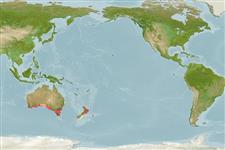Classification / Names
Common names from other countries
Main reference
Size / Weight / Age
Max length : 89.0 cm TL male/unsexed; (Ref. 27296); common length : 47.0 cm TL male/unsexed; (Ref. 9258); max. published weight: 9.4 kg (Ref. 9988); max. reported age: 26 years (Ref. 9072)
Length at first maturity
Lm ?, range 29 - 36 cm
Environment
Marine; brackish; pelagic-neritic; anadromous (Ref. 51243); depth range 30 - 39 m (Ref. 58489)
Climate / Range
Subtropical, preferred 15°C (Ref. 107945); 27°S - 47°S, 112°E - 176°W
Distribution
Southwest Pacific: southern Australia (including Tasmania, Lord Howe Island and Norfolk Island), usually Brisbane to Western Victoria, rarely to Western Australia; and New Zealand (including Chatham and Kermadec Islands).
Countries | FAO areas | Ecosystems | Occurrences | Introductions
Short description
Dorsal
spines
(total): 9;
Dorsal
soft rays
(total): 15-17;
Anal
spines: 3;
Anal
soft rays: 9 - 10;
Vertebrae: 25. Adults are dark blue-green above and silvery below, with irregularly defined spots arranged laterally in indistinct rows (Ref. 33616). Length of upper lobe of caudal fin < 29.9% SL, more or less equal to, or less than, the length fo the head (Ref. 9701).
IUCN Red List Status (Ref. 115185)
Threat to humans
Harmless
Human uses
Fisheries: commercial; gamefish: yes; bait: usually
Tools
Special reports
Download XML
Internet sources
Estimates of some properties based on models
Phylogenetic diversity index
PD50 = 0.6250 many relatives (e.g. carps) 0.5 - 2.0 few relatives (e.g. lungfishes)
Trophic Level
4.1 ±0.6 se; Based on diet studies.
Resilience
Medium, minimum population doubling time 1.4 - 4.4 years (K=0.2-0.3; tm=4)
Vulnerability
Moderate vulnerability (41 of 100)
Price category
